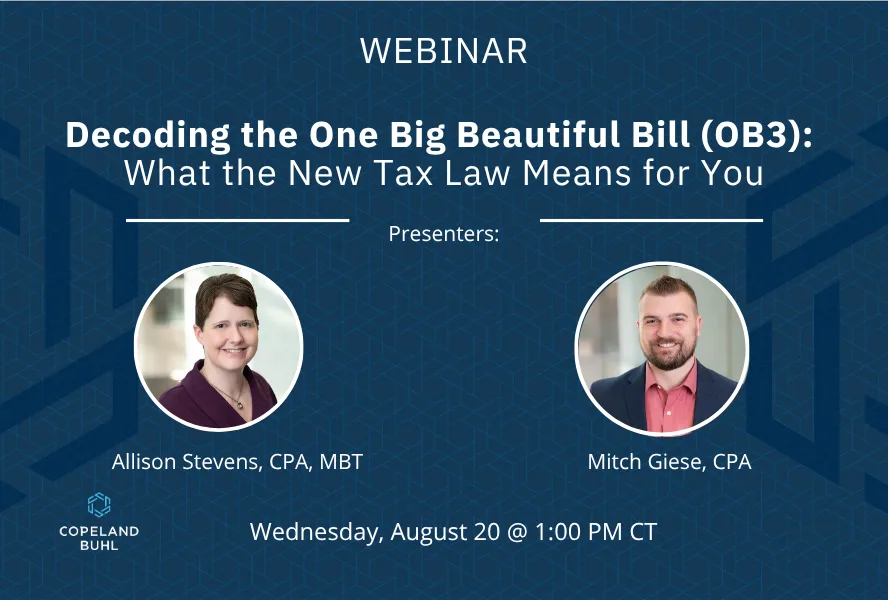
The One Big Beautiful Bill Act (OB3), recently passed into law, is a sweeping piece of tax legislation containing many extensions to existing provisions as well as key changes to others. Whether you are a household managing expenses or a business preparing for growth, OB3 brings changes that could affect your financial and business decisions.
Below, we break down OB3 into digestible, actionable sections you can read. From SALT caps to business deductions and credits, here’s what you need to know—and plan for.
Want to learn more from a past webinar instead? To help you navigate these complex changes, we invite you to a complimentary webinar that was hosted by Copeland Buhl tax experts and the authors of our recent analysis, Allison Stevens, CPA, MBT, and Mitch Giese, CPA.
Individual Taxpayer Updates
Individual Tax Rates
Individual tax rates were scheduled to increase in 2026. OB3 permanently extends the current tax rates, which prevents an increase that would have impacted most individual taxpayers.
State and Local Tax Deduction Cap Changes
Starting in 2025, the cap on the State and Local Tax (SALT) deduction increases to $40,000. However, this benefit phases out for households with adjusted gross income (AGI) above $500,000 for single taxpayers and married individuals filing jointly ($250,000 for married filing separately), where the deduction is reduced by 30% of the excess AGI over the threshold. For high earners, this effectively reins in the benefit, potentially reverting it back to the existing limitation of $10,000.
Minnesota Note: The state’s cap remains at $10,000 in 2025, but the deduction becomes unlimited in 2026—unless the MN Legislature acts.
New Deduction for Tips and Overtime (tax years 2025–2028)
Taxpayers in tip-based industries may now qualify for up to $25,000 ($12,500 for single taxpayers) in deductions for their tip income, subject to income phaseouts. However, eligibility depends on IRS-defined occupations and the tip income must be voluntary. Service charges will not qualify for the deduction. While this deduction will limit the amount of tips subject to income tax, it is important to note that tips are still subject to Social Security and Medicare taxes.
Taxpayers who receive qualified overtime compensation may claim a deduction for up to $25,000 ($12,500 for single taxpayers) of this income. This only applies to overtime compensation required under section 7 of the Fair Labor Standards Act of 1938 that is more than the employee’s regular pay rate. For a worker who receives time and a half for overtime pay, only the half portion of the overtime is eligible for the deduction.
Individuals who are married filing separately will not qualify for either of these deductions.
Employers will need to report both the tips and overtime pay on the employees’ W-2s. Watch for guidance from the IRS for reporting requirements.
Vehicle Loan Interest: Now Deductible (Subject to Restrictions)
For cars, vans, SUVs, pickups, and motorcycles purchased after January 1, 2025, buyers can deduct up to $10,000 per year in loan interest. The deduction is reduced once a taxpayer’s income is too high ($200k for married filing joint taxpayers, $100k for single).
In addition to the income limitations, the vehicle itself must meet certain requirements. The vehicle must be new, with final assembly in the US, and have a gross vehicle weight rating under 14,000 lbs. Used vehicles are excluded from this deduction. Vehicle information, including VIN number, must be included with your individual tax return if you claim a deduction.
Senior Deduction (tax years 2025 – 2028)
The new senior deduction allows taxpayers aged 65+ to deduct up to $6,000 per taxpayer. This deduction is phased out starting at AGI of $75,000 for single taxpayers or $150,000 for joint filers. The deduction is reduced by 6% of income over those income limits. No deduction is allowed if AGI is over $175,000 (single) or $250,000 (MFJ).
This new deduction increases the amount of income a senior may receive without paying federal income tax. Careful planning of retirement withdrawals can ensure you take advantage of this new opportunity.
Child Tax Credit Boost
Starting tax year 2026, the Child Tax Credit increases to $2,200 per child. At least one taxpayer on the return must provide a valid Social Security Number to be eligible for the credit.
Trump Accounts: Long-Term Child Savings
These accounts are expected to be available in July 2026 for beneficiaries who have not turned 18 prior to the close of the calendar year. They are treated similarly to an IRA but with limitations on how the money can be invested. Additionally, the federal government will contribute $1,000 for children born between 2025–2028. Annual contributions of up to $5,000 grow tax-free for the beneficiary, although there is no tax deduction for making contributions to the accounts. Unlike traditional IRAs, there is no earned income requirement for contributions, which means parents can start saving for their child’s retirement sooner. Funds generally cannot be withdrawn before the child turns 18.
More guidance is expected with details on how these accounts will operate.
Charitable Giving
Above-the-Line Charitable Deduction
Even if you don’t itemize, you may deduct up to $2,000 (MFJ) or $1,000 (Single) in cash donations starting in 2026. Contributions to Donor-Advised Funds (DAFs) do not qualify.
A New Floor for Charity
Starting in 2026, deductions are only allowed for contributions exceeding 0.5% of AGI.
Business Tax Provisions
100% Bonus Depreciation is Back—Permanently
Businesses can once again fully expense qualifying property placed in service after January 19, 2025. However, Minnesota and other states do not currently allow this increased deduction, so the fixed asset purchases may not be written off entirely in these states.
Section 179 Expansions
The expensing cap for Section 179 increases to $2.5 million with a phase-out starting at $4 million. This allows businesses to immediately expense more fixed asset purchases in a year and continues to be a key planning tool for many businesses.
Qualified Business Income Deduction: Now Locked In
The Qualified Business Income (QBI) deduction has been made permanent. This deduction allows eligible business owners to deduct up to 20% of their business income. The phase-out thresholds have increased to allow more businesses to qualify for the deduction and there’s now a minimum $400 deduction for businesses earning at least $1,000 in qualified income.
Section 1202: Improved Benefits for Small Business Investors
Small business stock exclusions under IRC Section 1202 are enhanced. Now you can exclude:
- 50% of gains after 3 years, 75% after 4 years, and 100% after 5 years
The eligible exclusion cap rises to $15 million and qualifying companies may now have up to $75 million in assets before stock issuance to be considered a qualified small business.
Qualified Opportunity Zones
Capital gains may be deferred if the taxpayer invests in a Qualified Opportunity Zone (QOZ) or a new Qualified Rural Opportunity Fund. The new law extends QOZ treatment permanently and starts a rolling 10-year determination date of 7/1/2026 that expands eligible areas. In addition to the initial gain deferral, there is an opportunity to permanently exclude capital gains if the QOZ investment is held for at least 10 years.
Research and Development Costs
Businesses will have the option to expense Research and Development (R&D) costs starting in 2025 (2022 for eligible small businesses). All businesses have the option to deduct the R&D costs that were capitalized between 2022-2024 in 2025 or 2026. Copeland Buhl will aid in determining the most advantageous choice for each business with R&D.
Credits: What’s Expiring and What’s New
Expiring
- Clean Vehicle Credits: Expires for electric vehicle purchases made after September 30, 2025. If you are considering buying an electric vehicle that qualifies for the credit, act quickly before the credit expires.
- Energy Efficient Home Improvement Credit & the Residential Clean Energy Credit: Expire on December 31, 2025. This includes credits for energy efficient air conditioners, windows, furnaces, solar panels, etc. These items would need to be installed before the expiration date to qualify for the credit.
- Energy efficient commercial buildings deduction (179D) & New Energy Efficient Home Credit (45L): Expire on June 30, 2026.
Newly Introduced or Expanded
- Tip Credit: this credit was only allowed previously in food and beverage industries. It has been expanded to include beauty service businesses where tipping is customary.
- Child and Dependent Care Credit: Increased from 35% to 50% of qualified dependent care expenses like daycare.
- Paid Family Leave Credit: Expanded to include insurance premiums paid to fund family and medical leave benefits.
State Considerations
Minnesota Nonconformity: A Complex Picture
Because Minnesota conforms to the federal tax code only up to 2023, it does not follow any of these new rules without legislative action. The treatment of depreciation, §1202 gain exclusion, charitable deductions, and more will diverge significantly from federal rules. For now, you can expect ongoing state/federal reconciliation challenges.
Final Thoughts
While OB3 introduces a range of tax changes and provisions made permanent, it also demands careful planning, especially for those in high-income brackets or operating across multiple states. From child savings incentives to clean energy sunsetting, the bill affects many corners of the tax landscape.
If you have questions about how these provisions apply to you or your business, please reach out to your Copeland Buhl professional or complete the Contact Us form.








